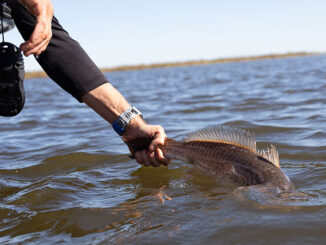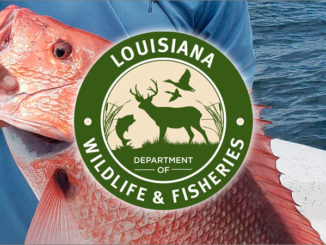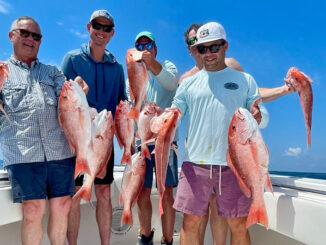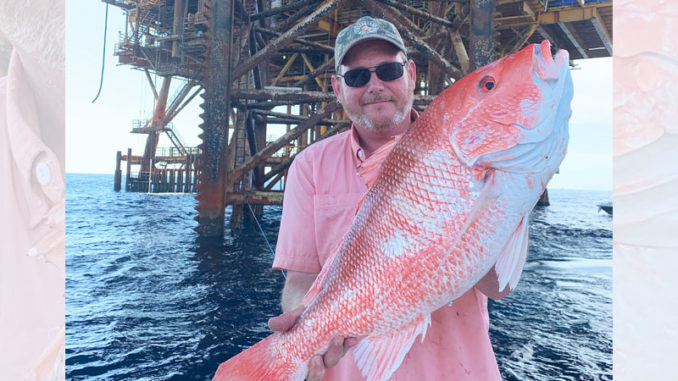
Cooler water plus lots of structure equals fish magnets for Louisiana anglers
When calm days allow easy runs throughout the Delta’s nearshore rig, anglers in skiffs and bay boats will find a wide array of light-tackle action on structures of various size and design. More than a day-saver, or last-ditch option, Capt. Billy Wallbaum of Boothville’s Paradise Plus Guide Service views these towering structures as downright priorities. In fact, some of his business is summer-rig driven.
“You gotta go to them, they are indispensable in the summertime,” he said. “During the summer, as long as the winds allow, I will catch my biggest trout of the year on nearshore rigs. I have customers that I only see a couple of times a year because they know the possibility of what can go on at those rigs.”
So, what’s the attraction? For starters, departing the marsh and coastal shallows often means departing bath water conditions. Particularly on calm days with minimal atmospheric disturbance, long hours of solar heating can make the skinny areas nearly unbearably hot with low dissolved oxygen levels.
Head to deeper water and you’ll find cooler and more oxygenated environments that appeal to summer fish. Past that, there’s no overstating the value of something different.
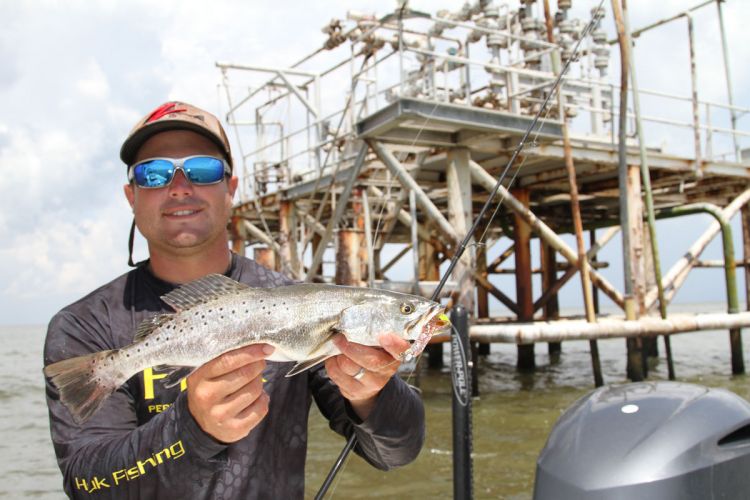
“Several times, I’ve been in the situation where there are several boats sitting on the islands (in Breton Sound) and maybe they’re catching them; maybe they’re not, but the fishing pressure forces you to go try different stuff,” said Capt. Ross Montet of Cajun Fishing Adventures. “Bigger fish are typically smarter, so they tend to isolate more. They’ll be in smaller groups.
“You’ll have mostly school size trout on the islands, but they start getting smarter as they get older, so those bigger ones typically move out to the rigs.”
Who’s home
Paradise Plus owner, Capt. Anthony Randazzo, offered this encouraging outlook: “The sky is the limit when fishing around nearshore rigs during the summer.”
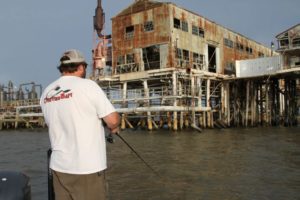
Closer to shore in the 6- to 10-foot range, Randazzo looks for large redfish keeping company with the trout. Other possibilities include flounder, sand trout, ladyfish, sheepshead, black drum and jack crevalle. Farther out, in 25 feet or more, you can add bluefish, Spanish mackerel, cobia and tripletail join the mix.
Capt. Ross Montet, of Cajun Fishing Adventures in Buras, adds mangrove and red snapper to his list. With the latter’s ridiculously brief federal season, recreational anglers appreciate significantly longer access to these tasty fish, along with their dark brown cousins, on state water rigs (inside 9 nautical miles)
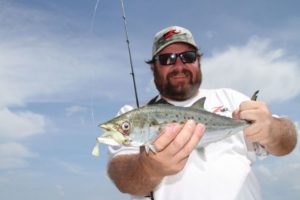
Summer river conditions are usually fairly moderate, but an excessively dirty flow will keep the blues, mackerel and spadefish in deeper water; while big winds churning coastal waters can have a similar effect on these species. Beyond that, Wallbaum says close attention to the variables of tide, wind direction, sky conditions, barometer, etc. will reveal replicable patterns.
“There’s not a specific set of conditions, you just have to fish those structures over and over and over and keep a log as to what you catch there in the (prevailing) conditions,” he said. “For example, if you have a rolling tide, I don’t think they eat as well, they’re fighting the water until it slows down as it comes toward the slack of the low or high tide.
“And then, you have to look at water clarity — where’s the wind blowing the dirty water into. I want the cleanest water I can find, if I’m fishing deep — over 10 feet.”
What to look for
When it comes to selecting rigs, there are two schools of thought, both meriting consideration. First, smaller, unassuming rigs attract less traffic, so while they may not hold huge numbers of fish, their residents are typically less pressured and, therefore, more cooperative.
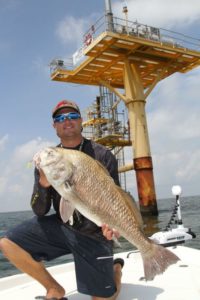
On the other hand, larger, more complex structures offer the benefit of more mass in the water. Not only does that mean more places for fish to inhabit, but also great water dynamics.
“If the tides are strong, I like a bigger rig to have more legs in the water to break up the current; but if the tides are weaker, you can fish smaller structures,” Wallbaum said. “I have some that are simple well heads and some that are (more complex structures). It just depends on the situation.”
Montet offers this thought: “I like the bigger structures, especially the ones that have additional structure in the water, like piers or an old generator that fell into the water. With the small rigs, you’re bouncing a lot. You might only be at one for a few minutes, but the bigger rigs give you more to fish.”
The wind
That said, wind direction dictates the savvy angler’s day plan. Knowing what to expect for the morning run, as well as the midday and afternoon hours helps you pick a handful of rigs in the lee.
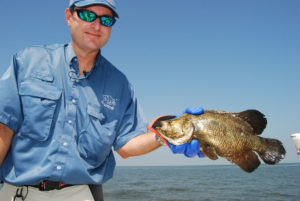
Notably, this is more than a navigational safety and comfort concern. That stuff’s clearly important, but as Wallbaum points out, working with the wind bears great impact on your ability to effectively approach the fish.
“If I’ve got a south or west wind, I’m going to go to Breton Sound; if I’ve got a north or east wind, I’m gonna go to West Bay,” Wallbaum said. “I try to let the land knock down the wind as much as I can to make it calmer.
“People don’t realize how much your boat noise can affect a trout bite. They think ‘I’m up at this rig and it’s making all kind of noise.’ Well, that rig was making noise when the fish swam up to it, but then a boat pulls in and it’s bouncing up and down — kaboosh, kaboosh. It’s a different noise and it freaks them out.”
Similarly, idling up to a shallow rig with the outboard and clumsily slapping a rig hook on the structure also creates more commotion than many fish — especially the ultra-wary trout — will tolerate. A better course of action, Wallbaum said, would be to shut down at least 50 feet from the rig and use the trolling motor to quietly ease into position.
Side scanning sonar can be a rig angler’s best friend by showing you who’s holding where and significantly cutting down your search time. One of the most important variables for any rig is bait and only structures with a steady food source will consistently hold fish. Thus, spotting bait schools bodes well for your success.
How to hook ‘em
Most days, you can’t go wrong with medium-heavy spinning outfits, braided line, 20- to 30-pound fluorocarbon leaders and jigs for trout and redfish, mackerel, bluefish, cobia and even the big black drum and jack crevalle that frequent nearshore rigs. Easy to cast and availing to multiple presentations from vertical hops, to swimming retrieves, to long pendulum style falls; jigs also allow you to quickly change body style and/or color to dial in what the fish prefer.
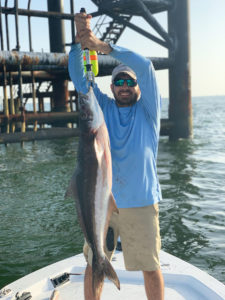
Wallbaum likes to mix up the looks with paddletails in 3- to 6-inch sizes and eel bodies. Randazzo suggests keeping assorted sizes of jig heads to control the rate of decent of the lures in various winds and currents. Large bucktail jigs with plastic trailers, he notes, are great for cobia.
“On very calm days we even experience incredible early morning topwater lure action here,” Randazzo said. “It is not uncommon to occasionally yo-yo a jig spinner with soft plastic minnow and crabs close to the bottom when reds are present.”
Another reaction bait tactic: Trolling a rig’s perimeter with lipless crankbaits is a good way to bring hungry fish charging out from the shadows. Mark each bite and note that multiple shots on the same spot indicates you’ve found the grouping point where targeted jig casts should prove productive.
Note: Mackerel and bluefish often grab the same baits fished for trout, reds and others; but if those toothy fish start clipping off your baits, add a trace of wire leader to minimize your losses.
Natural baits
If you like natural baits, Randazzo says Carolina-rigged or free-lined live shrimp or pogies produce well around nearshore rigs. Montet will also fish live baits under slip cork rigs when he’s targeting suspended fish.
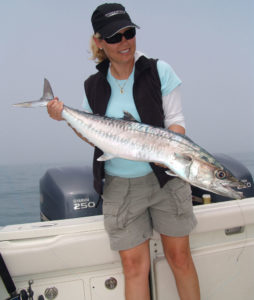
For his snapper duty, Montet prefers a heavy spinning rod with a fast tip and a 4500- to 6500-class reel loaded with 80-pound braided main line with about four feet of 30- to 60-pound fluorocarbon leader. He’ll fish live or cut menhaden, cut mullet or speckled trout bellies from the cleaning table.
“With live bait, the hook placement is less important, but if I’m fishing cut bait, I want to make sure that hook 100-percent disappears,” Montet said. “The perfect cut bait would be about 1-inch square and that’s about an ounce or two of weight. If we use trout bellies, they don’t sink down as fast.”
Montet’s deployment strategy harnesses the power of the water to influence his bait’s position. He’ll cast to the downcurrent side of a rig leg where the water rushing past the structure grabs his bait and forces it down. Casting to either side means a randomly drifting bait, but hitching a ride on those eddies helps him reach deeper without addition fish-spooking weights.
“The whole time I’m doing this, I keep my spool wide open,” he said. “Let the current pull it down, pull it down, pull it down. You know instantly when you have a fish because you’ll see that line speeding out of your spool.
“When that happens, you close your bail, set the hook and then run to the back of the boat to try and get him out of there. When you’re fishing the rigs, the first thing those fish want to do is go right back into it.”
Keep your eye on the sky
Along with baits, terminal tackle, and landing net, add “weather watching” to your summer rigs check list. Amid the rod-bending revelry of summer rig fishing, take precautions to keep everyone safe and comfortable. That starts with generous layers of sunscreen and lots of water, but don’t overlook the pleasant solace of a larger rig’s cooling shadow.
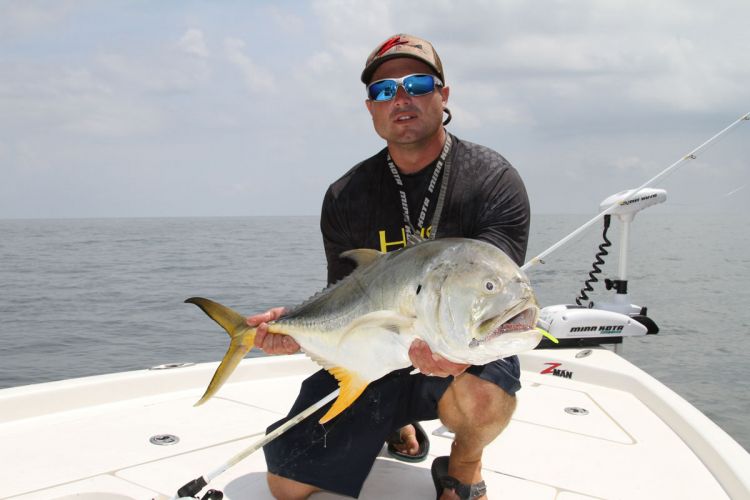
Thankfully, summer offers a lot of calm mornings that allow anglers to run where they please, fish what they want and simply pay attention to what can be a rapidly changing scenario. Pop-up storms are the bane of coastal missions that venture just far enough from the passes to risk challenging return runs, should the boom-and-flash show commence.
“Obviously, in Southern Louisiana, you can’t predict the weather,” warned Capt. Ross Montet. “You have to watch the radar so you know what’s going on. You don’t want to be out there and have a squall pop up.”
As Montet said, typical summer high pressure conditions bring relatively stable weather through the afternoon, when predictable showers occur. Low pressure systems, he said, are the trouble makers given to frequent temper tantrums.
“The wind will usually be up a little higher, you’ll have spottier showers in the morning, midday or afternoon. Somedays are a complete rain-out and you’ll want to stick inside.
“The good thing is that rain water will actually cool off the surface temperature, which can make your inshore bite last longer. It can even be good while the rain is coming through. I tell my people, as long as there’s no lightning, we can fish as long as you want; but if it starts lightning, we gone.”
